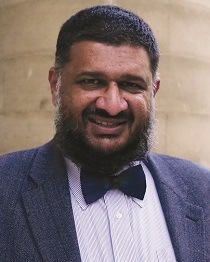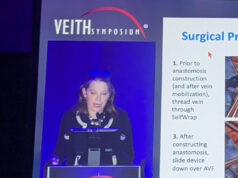
Difficulties in cannulation are currently as pressing as any other challenge facing patients who undergo device-enabled arteriovenous fistula (AVF) creation for dialysis. This was a central message presented by Neghae Mawla (Dallas Nephrology Associates, Dallas, USA) at the Paris Vascular Insights meeting (PVI 2021; 21–23 October, Paris, France).
Partaking in a session debating device-created fistulas— which also featured discussions on the two leading products in this space, the WavelinQ (BD) and Ellipsys (Medtronic) systems—Mawla posed the following question at the top of his presentation: Are nephrologists happy with [these] fistulas? He went on to note that, ultimately, this should be dictated by whether or not dialysis patients themselves are happy with device-created AVFs, as their interests are paramount.
In the world of vascular access for dialysis, he continued, freedom from tunnelled catheters is synonymous with happiness—from patient and physician perspectives alike. Mawla also quipped that, with the odd exception, “a permanent access is a better access”, as avoiding central venous catheter (CVC) usage means reduced risks of infection, thrombosis, decreased dialysis adequacy, and other complications.
Mawla stated that the two-to-three-month timeline for what he dubbed ‘phase one’ of dialysis initiation, from the patient’s initial appointment with a general nephrologist to them undergoing fistula creation, is broadly similar between surgical AVF (sAVF) and device-created AVF approaches. However, he continued, things get “interesting” when it comes to using that fistula to facilitate dialysis.
“Usually, the timeframe for surgical fistulas—from first cannulation to catheter removal—is around three-to-four weeks,” he said. “And, this is generally true regardless of the anastomosis’ location.” But, Mawla then reported that this timeframe with device-created fistulas is closer to eight weeks, if not longer. “This is both device-independent and provider-independent,” he continued. “All of our device-created AVFs have the same struggles—it is just the nature of the fistula, and its physiological differences.”
Mawla then informed the PVI audience that difficulties relating to cannulation at the dialysis centre are a crucial contributing factor in this increased timeframe and subsequent delays in fistula usage. “If we are going to talk about unhappiness from a device-created AVF perspective, our focus should be here, because the patients get frustrated, the dialysis staff get frustrated, and then ultimately the nephrologists get frustrated as well,” he added.
There is very little literature on this phenomenon as things stand, Mawla continued. “Until we get past this educational hump, I think cannulation will be our holdback,” he said. “It is not screening anymore, or procedural techniques. There is still the issue of maturation, but I think cannulation is a bigger problem.” He further noted that a key, short-term advantage of device-based AVFs over sAVFs—the fact the former can be performed by interventional nephrologists at their centre, without the need for increased timelines and additional appointments—is somewhat lost if the patient is referred to a vascular access surgeon to undergo the procedure.
Mawla did also touch on some of the other key benefits held by device-created fistulas, including their longevity as functional dialysis accesses—citing patients at his centre who no longer require follow-up more than five years on from their creation procedure because “they are doing so well”. He also pointed to the fact that patient satisfaction is “clearly very high”, as per several major studies, when it comes to device-created AVFs—largely due to the operating techniques used and associated cosmesis.
“In summary, it is about setting appropriate expectations for happiness,” Mawla concluded. “For nephrologists, it is really about understanding the technology, and appropriate patient selection based on which fistula will provide the strongest dialysis option.” He further emphasised the need for dialysis staff to appreciate nuances between device-created and surgical fistulas, and the importance of making these decisions contingent on what is best for the patient as opposed to the clinician’s own preference.











